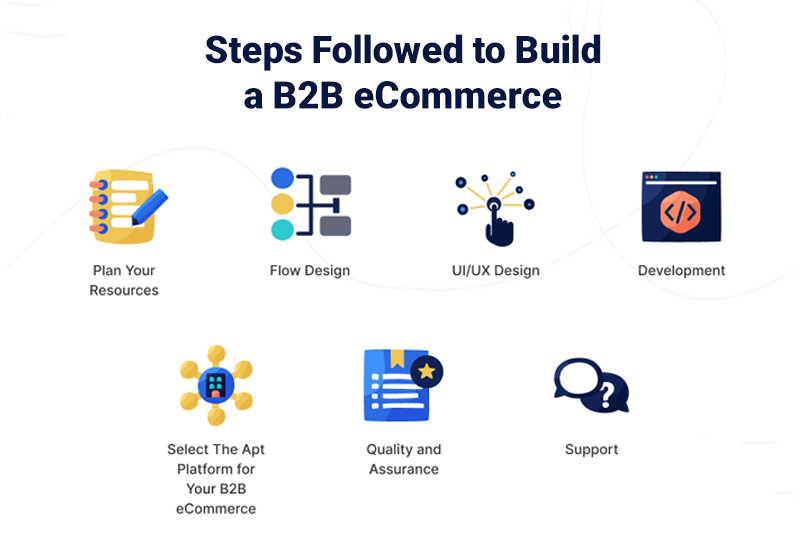Steps followed to Build a B2B eCommerce

Building a successful B2B (business-to-business) eCommerce platform requires careful planning, a deep understanding of your target audience, and the utilization of appropriate technologies. Here are the steps you should follow to create a successful B2B eCommerce platform:
Market Research and Analysis:
- Identify your target B2B audience and their specific needs.
- Study your competitors and understand their strengths and weaknesses.
- Determine the market trends, demands, and gaps that your platform can address.
Business Model and Strategy:
- Define your unique selling proposition (USP) – what sets your B2B platform apart from others.
- Choose a business model (e.g., marketplace, distributor, wholesaler) that aligns with your goals and market research.
Platform Selection:
- Choose the right eCommerce platform or software that caters to B2B needs. Some popular options include Magento, Shopify Plus, WooCommerce, and BigCommerce B2B.
Features and Functionalities:
- Include essential B2B features such as custom pricing, bulk ordering, tiered pricing, negotiated quotes, and customer-specific catalogs.
- Implement robust inventory management and order tracking capabilities.
- Integrate a secure payment gateway with support for net terms or credit accounts.
User Experience (UX) Design:
- Design an intuitive, user-friendly interface that simplifies the purchasing process.
- Focus on responsive design to ensure seamless experiences across various devices.
Product Catalog and Management:
- Organize your product catalog with categories, subcategories, and detailed product information.
- Enable efficient search and filtering options for customers to easily find products.
Personalization and Customization:
- Implement tools that allow customers to create personalized accounts with saved preferences and order history.
- Offer relevant product recommendations based on customer behavior and purchase history.
Security and Compliance:
- Prioritize security measures to protect customer data, payment information, and transactions.
- Ensure compliance with data protection regulations (e.g., GDPR, CCPA) as applicable.
Integration and Scalability:
- Integrate with enterprise resource planning (ERP) systems, customer relationship management (CRM) software, and other essential tools.
- Plan for scalability to accommodate future growth and increased user traffic.
Marketing and Promotion:
- Develop a marketing strategy to promote your B2B platform to your target audience.
- Utilize content marketing, email campaigns, social media, and possibly targeted advertising.
Launch and Monitoring:
- Launch your B2B eCommerce platform to the public and monitor its performance closely.
- Gather insights from analytics tools to track user behavior and identify areas for improvement.
Customer Support and Training:
- Provide robust customer support through various channels (email, chat, phone).
- Offer training resources to help customers navigate the platform and its features.
Testing and Quality Assurance:
- Thoroughly test the platform for bugs, glitches, and usability issues.
- Conduct beta testing with a select group of users to gather feedback.
Launch and Monitoring:
- Launch your B2B eCommerce platform to the public and monitor its performance closely.
- Gather insights from analytics tools to track user behavior and identify areas for improvement.
Continuous Improvement:
Continuously gather user feedback and make iterative improvements to enhance the platform’s functionality and user experience.
Building a successful B2B eCommerce platform is a complex undertaking that requires a deep understanding of both business processes and technological solutions. By following these steps and remaining dedicated to providing value to your B2B customers, you can create a platform that fosters strong relationships and drives business growth.


